
Count Gregory Petrovich Shuvalov (1804-1859) was one of the Russian nobles of the second quarter of the 19th century, who changed his religion from orthodoxy to Catholicism and emigrated to Catholic Europe.

Count Gregory Petrovich Shuvalov (1804-1859) was one of the Russian nobles of the second quarter of the 19th century, who changed his religion from orthodoxy to Catholicism and emigrated to Catholic Europe.
Gregory Shuvalov was the youngest son of Lieutenant-General Peter Shuvalov, a nephew of the governor-general of Moscow Alexey Shcherbatov. His initial education was in the Jesuit hostel in Saint Petersburg, since 1817 he studied in Switzerland and Italy. In 1823-1826 he served in the Hussars. Shortly after his marriage, he retired and, like the Saltykov princes, had gone with his family abroad. He lived in Italy, where he attended lectures by Giovanni La Cecilia, was engaged in literary work and wrote sonnets.
The death of one of his sons and his wife's illness was a serious spiritual drama, and forced him to turn to God. In Paris, he was a frequent guest at Sophie Swetchine's salon, where he met Prince Ivan Gagarin. In 1843 Shuvalov converted to Catholicism and in the mid-1850s he was a novice in the Order of Barnabites and in 1856 in Milan he became a monk as Father Augustine Mary. Shuvalov died in a Catholic convent in 1859. He wrote an autobiography: "My Conversion and My Vocation". (London, Washbourne, 1877); originally published in French: "Ma conversion et ma vocation".
Since 1824, he was married to Princess Sophie Alexandrovna Saltykova (1806-1841), daughter of Alexander Saltykov. She made a lot of effort to return her husband to the Christian faith. Sophie wanted to accept Catholicism, but at the request of her husband postponed her decision. Due to her early death, she could not fulfill her desire; her husband was very sorry afterwards. Sophie Saltykova died of consumption. He had four sons:
Peter (1826-1882), member of the board of the Minister of Internal Affairs, was, like his father, a Catholic.
Grgorevich Alexander (1828-1829).
Elena (1830-1884), returned to the Orthodox Church and in her memoirs she spoke about the religious quests of her father; she married a collector of vintage music, Alexander Ya Skaryatin (1815-1884).
Natalia
Tamborra Angelo. The Catholic Church and the Russian Orthodox Church: two centuries of confrontation and dialogue. Biblical Theological Institute of St.. Andrew, 2007. pp. 180–185.
Russia and Italy. Volume 2. Russian Academy of Sciences Institute of World History, 1996. pp. 144–6.

Julia, Princess of Battenberg, previously Countess of Battenberg and Countess Julia von Hauke, was the wife of Prince Alexander of Hesse and by Rhine, the third son of Louis II, Grand Duke of Hesse. The daughter of a Polish general of German descent, she was not of princely origin. She became a lady-in-waiting to Marie of Hesse, wife of the future Emperor Alexander II and a sister of Prince Alexander of Hesse and by Rhine, whom she married, having met him in the course of her duties. The marriage of social unequals was deemed morganatic, but the Duke of Hesse gave her her own title of nobility as Princess of Battenberg. She was the mother of Alexander, Prince of Bulgaria, and is an ancestor of Charles III and to the current generations of the Spanish royal family.
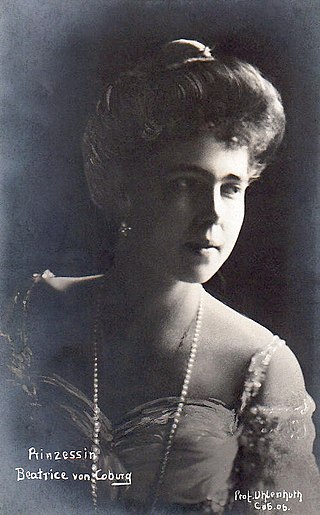
Princess Beatrice of Saxe-Coburg and Gotha was a member of the British royal family, a male-line granddaughter of Queen Victoria. She later married into the Spanish royal family, and was the wife of Prince Alfonso de Orleans y Borbón, Infante of Spain, a first cousin of Alfonso XIII of Spain.

Anne Sophie Swetchine, known as Madame Swetchine, was a Russian mystic, born in Moscow, and famous for her salon in Paris.
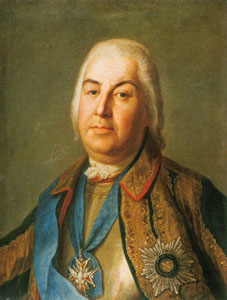
Count Pyotr Semyonovich Saltykov was a Russian statesman and a military officer, promoted to the rank of Field marshal on 18 August 1759. Saltykov is one of the finest commanders in Russian history. The experience of Saltykov's military art was adopted and developed by Pyotr A. Rumyantsev, who served in his troops.
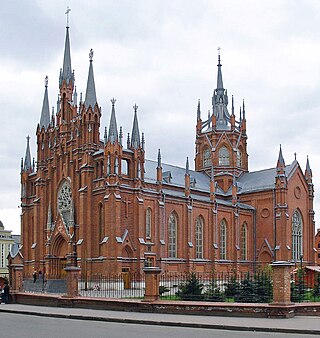
The Catholic Church in Russia is part of the worldwide Catholic Church, under the spiritual leadership of the Pope in Rome.

Grand Duchess Maria Nikolaevna of Russia was a daughter of Emperor Nicholas I of Russia, and sister of Alexander II. In 1839 she married Maximilian, Duke of Leuchtenberg. She was an art collector and President of the Imperial Academy of Arts in Saint Petersburg.
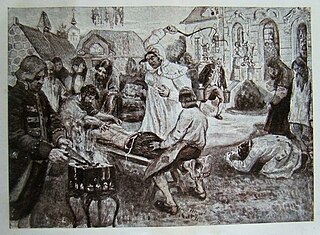
Darya Nikolayevna Saltykova, commonly known as Saltychikha, was a Russian noblewoman from the Saltykov family, sadist, and serial killer from Moscow. She became notorious for torturing and killing many of her serfs, mostly females. Saltykova has been compared by many to the Hungarian "Blood Countess," Elizabeth Báthory (1560-1614), who allegedly committed similar crimes in her home, Čachtice Castle, against servant girls and local serfs, although historians debate the accuracy of these charges.
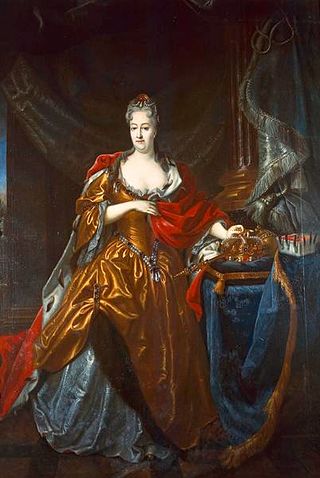
Christiane Eberhardine of Brandenburg-Bayreuth was Electress of Saxony from 1694 to 1727 and Queen Consort of the Polish–Lithuanian Commonwealth from 1697 to 1727 by marriage to Augustus II the Strong. Not once throughout the whole of her thirty-year queenship did she set foot in Poland, instead living in Saxony in self-imposed exile. Born a German margravine, she was called Sachsens Betsäule, "Saxony's pillar of prayer", by her Protestant subjects for her refusal to convert to Catholicism. Despite the allegiance of Christiane Eberhardine and her mother-in-law, Anna Sophie of Denmark, to Lutheranism, her husband and son, later Augustus III, both became Catholics, ensuring Catholic succession in the Albertine lands after a century and a half.

Princess Charlotte of Württemberg, later known as Grand Duchess Elena Pavlovna, was the wife of Grand Duke Michael Pavlovich of Russia, the youngest son of Emperor Paul I of Russia and Duchess Sophie Dorothea of Württemberg.

Praskovia Fyodorovna Saltykova was the tsaritsa of Russia as the only wife of joint-Tsar Ivan V of Russia. She was the mother of Empress Anna of Russia. She played an important part as the most senior woman of the Russian court in 1698–1712.
Helena Ivanovna of Moscow was daughter of Ivan III the Great, Grand Prince of Moscow, and an uncrowned Grand Duchess of Lithuania and Queen of Poland as she would not convert from Eastern Orthodoxy to Catholicism. Her childless marriage to Grand Duke of Lithuania and later King of Poland Alexander Jagiellon was a constant source of tension between the Grand Duchy of Moscow and the Grand Duchy of Lithuania. Instead of guaranteeing peace, Helena's marriage gave her father Ivan III an excuse to interfere in Lithuanian affairs accusing Alexander of mistreating Helena and repressing Orthodox believers. This became the pretext to renew the Muscovite–Lithuanian Wars in 1500. The war ended with a six-year truce in 1503; the Grand Duchy of Lithuania lost about a third of its territory. Despite political tensions and religious differences, the marriage was a loving one and the royal couple was close. After her husband's death in 1506, Helena wanted to return to Moscow but was not allowed. When she planned to run away, she was arrested and reportedly poisoned.
Ingunde, Ingund, Ingundis or Ingunda, was the eldest child of Sigebert I, king of Austrasia, and his wife Brunhilda, daughter of King Athanagild of the Visigoths. She married Hermenegild and became the first Catholic queen of the Visigoths.
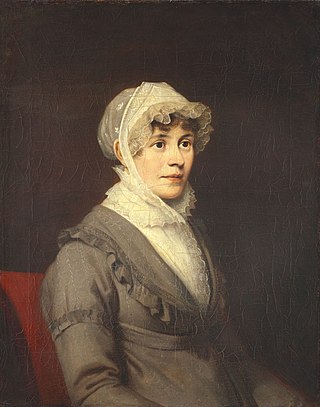
Countess Yekaterina Petrovna Rostopchina was a Russian aristocrat and writer. She was married to Fyodor Rostopchin, who served as governor of Moscow during the French Invasion of Russia.

Father Sergei Mikhailovich Solovyov was a Russian Symbolist poet, religious philosopher and an Orthodox priest. Solovyov was a grandson of the historian Sergey Solovyov, a nephew of the poet and philosopher Vladimir Solovyov, second cousin of Alexander Blok, and a friend of Andrei Bely.
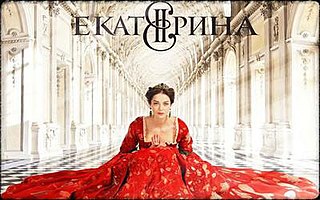
Ekaterina is a 2014 Russia-1 historical television series starring Marina Aleksandrova as the eventual Russian empress Catherine the Great. The first season tells the story of princess Sophie Friederike Auguste, and her rise to power to become Empress of Russia, following a coup d'état and the assassination of her husband, Peter III. The second season portrays the challenges she faces at home and abroad during the early years of her rule, as she tries to revitalise Russia to become one of the great powers of Europe, and becomes titled "the Great".

Countess Catherine Shuvalova,, was a Russian courtier, Empress Catherine II's Lady-in-waiting of the Imperial Court of Russia, confidant of Platon Zubov and Ober-Hofmeisterin of the Grand Duchess Elizabeth Alexeievna.
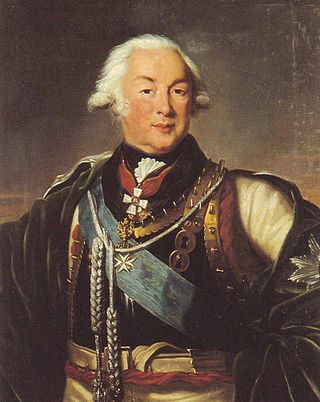
Count Ivan Petrovich Saltykov was a Russian Field Marshal, the Governor-General of Moscow from 1797 to 1804, and owner of the grand estate of Marfino.

Christianization of the Franks was the process of converting the pagan Franks to Catholicism during the late 5th century and early 6th century. It was started by Clovis I, regulus of Tournai, with the insistence of his wife, Clotilde and Saint Remigius, the bishop of Reims.
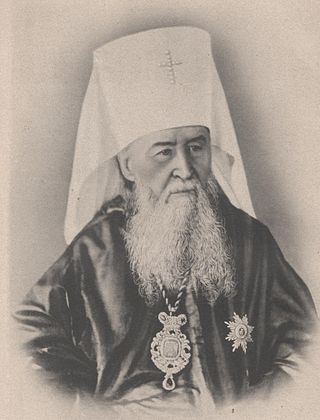
Joseph Semashko was an Eastern Catholic priest and bishop who played a central role in the highly controversial conversion of the Ruthenian Uniate Church of the western provinces of the Russian Empire to Russian Orthodoxy in 1837–1839. Subsequently, he became an archbishop in the Russian Orthodox hierarchy, elevated to the Metropolitan bishop of Vilnius and Lithuania in 1852.